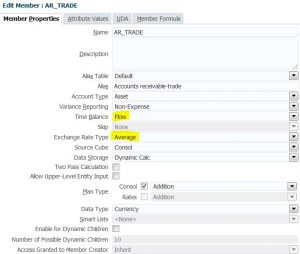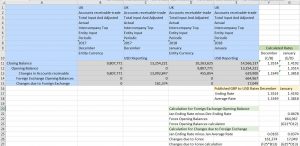In Hyperion Financial Management (HFM), we know that Assets and Liabilities are Balance Accounts where we assign Ending Rates while Revenues and Expenses are Flow Accounts where we assign Average Rates.
In Oracle Financial Consolidation and Close Cloud (FCCS), Balance Sheet and P&L Accounts are assigned the same Time Balance and Exchange Rate Type. For example, the following properties are assigned to AR_Trade.
- Time Balance = Flow
- Exchange Rate Type = Average
These properties do not mean that in FCCS, Balance Sheet Accounts are translated at Average Rates. They are still translated at Ending Rates. This is achieved by using the Movement dimension.
As shown below the Closing Balance of Accounts Receivable-Trade is translated at Ending Rates.
Note that the calculated rates (Columns F and G) for the Movement member Closing Balance (Row 11) in Dec and Jan are the Ending Rates for the respective months. Note also, that the Changes in Accounts Receivable (Row 13) are translated at Average Rates (Columns F and G).
By introducing the Movement members that calculate changes due to Foreign Exchange (Rows 14 and 15), the Closing Balance of the Asset account is translated at Ending Rates.



